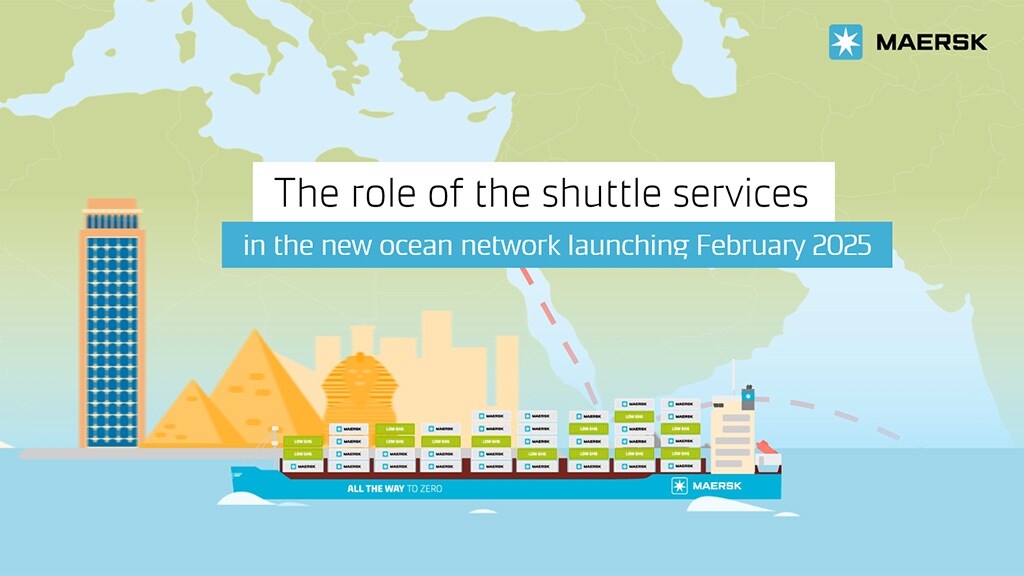Maersk is advancing on the design of a best-in-class ocean network to be implemented from February 2025. With 58 services and more than 6,000 port-to-port combination across the world, the new network will offer customers industry-leading reliability, geographic reach, and speed. Key to achieving this is a careful combination of 290 mainliner and shuttle vessels with a combined TEU of 3.4 million.
What is a mainliner service?
Mainliner services are the backbone of the new network. They:
- service key markets with consistently high volumes
- are designed around loops operated entirely by Maersk, or our partner Hapag-Lloyd
- have an average of eight port calls
The 26 mainliner services that make up the new network have fewer port calls than previously. This reduces the risk of disruption and improves transit times for cargo.
Shuttle services and strengths explained
The network will include a mainliner network offering robust and extensive coverage. This mainliner network will be supplemented by 32 shuttle services.
The shuttle services have the following advantages:
- fully operated by Maersk
- offering similar capacity to the mainliner vessels
- each service has just two or three port calls, on average
Shuttles ensure we continue to offer the same capacity as today, and the same geographic coverage. At the same time, they contribute significantly to achieving reliability, competitive transit times, and flexibility, as explained below. They also offer a high level of consistency and certainty to customers.
In addition to the shuttles, regular feeder coverage will be provided in close collaboration with strategic suppliers. This is similar to what is currently place with the 2M Alliance.
Raising service quality to new heights
The network is being carefully considered so that the different vessel types work alongside each other and deliver the greatest possible service quality to customers. Shuttles have the following benefits:
- Reliability – with mainliner loops and shuttle vessels having smaller numbers of port calls, there are fewer opportunities for disruption
- Competitive transit times – the combination of mainliners and shuttles offers access to all markets, while having fewer port calls means cargo can get to its destination efficiently and reliably.
- Flexibility – shuttle vessels can more easily and quickly respond to changes in demand
Key to the success of the network is making sure the different vessels are connected by port terminals with the exceptional productivity and reliability. These terminals, where either APM Terminals or Hapag-Lloyd has a level of operation control, serve as ‘hubs’.
Within the hubs, both the mainliners and the shuttles will be given the priority needed to transfer their cargo quickly and seamlessly. At the same time, investments in these hubs will ensure systems and processes are as efficient and reliable as possible and equipped to meet the needs of the new network.
Our new East-West Network
Preparations are underway to ensure the network will be ready to implement from 1 February 2025. Between now and then, we will continue to share insights into the network’s design and how it will achieve its goals. That includes aiming to reach +90% schedule reliability once the network is fully phased in, as well as offering customers competitive transit time and greater access to Maersk’s wider range of transportation products and logistical services.
To stay up to the date with the latest information, visit our dedicated page on the Network of the Future.
Anything you need, we’re here to help
I agree to receive logistics related news and marketing updates by email, phone, messaging services (e.g. WhatsApp) and other digital platforms, including but not limited to social media (e.g., LinkedIn) from A. P. Moller-Maersk and its affiliated companies (see latest company overview). I understand that I can opt out of such Maersk communications at any time by clicking the unsubscribe link. To see how we use your personal data, please read our Privacy Notification.
By completing this form, you confirm that you agree to the use of your personal data by Maersk as described in our Privacy Notification.

